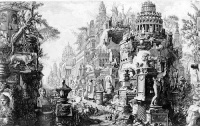Vedute (Piranesi)
From The Art and Popular Culture Encyclopedia
|
Related e |
|
Featured: |
The Vedute (Eng: Views) is the name given to the etchings of Piranesi that deal with the ruins of Rome. His first work was in this series was Prima parte di Architettura e Prospettive (1743), followed in 1745 by Varie Vedute di Roma Antica e Moderna. Piranesi was able to faithfully imitate the actual remains of a fabric; his invention in catching the design of the original architect provided the missing parts; his masterful skill at engraving introduced groups of vases, altars, tombs that were absent in reality; and his broad and scientific distribution of light and shade completed the picture, creating a striking effect from the whole view. Some of his later work was completed by his children and several pupils.
Piranesi's son and coadjutor, Francesco, collected and preserved his plates, in which the freer lines of the etching-needle largely supplemented the severity of burin work. Twenty nine folio volumes containing about 2000 prints appeared in Paris (1835 - 1837). The late Baroque works of Claude Lorrain, Salvatore Rosa, and others had featured romantic and fantastic depictions of ruins; in part as a memento mori or as a reminiscence of a golden age of construction. His reproductions of real and recreated Roman ruins were a strong influence on Neoclassicism.
See also


